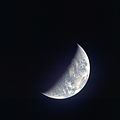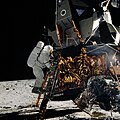Apollo 12
Apollo 12 was the sixth crewed flight in the Apollo program. It was the second crewed spacecraft to land on the Moon. Apollo 12 was launched on November 14, 1969.[1]: Script error: The function "hyphen2dash" does not exist.  Charles "Pete" Conrad and Alan Bean become the third and fourth persons to stand on the lunar surface, while Richard Gordon stayed in orbit around the Moon. The two astronauts spent over seven hours exploring the surface of the Ocean of Storms.[1]: Script error: The function "hyphen2dash" does not exist.  They brought back pieces of Surveyor III which had landed on the Moon in April 1967.[2] They set up a number of experiments which would continue to collect information after they left. The Lunar ascent stage, the part that helped it take off from the surface, was deliberately crashed back onto the Moon so that shock waves could be measured by seismic equipment left behind.[2]
| Mission type | Crewed lunar landing |
|---|---|
| Operator | NASA |
| COSPAR ID | |
| Spacecraft properties | |
| Spacecraft | |
| Manufacturer |
|
| Crew | |
| Crew size | 3 |
| Members | |
| Orbital parameters | |
| Reference system | Selenocentric |

| |
Apollo 12 Media
Apollo 12 launches from Kennedy Space Center, November 14, 1969
Lunar Module Intrepid above the Moon. The small crater in the foreground is Ammonius; the large crater at right is Herschel. Photograph by Richard F. Gordon Jr. on board the Command Module Yankee Clipper.
References
- ↑ 1.0 1.1 Furniss, Tim (2001). The History of Space Vehicles. London: Grange Books. ISBN 1-84013-370-8.
- ↑ 2.0 2.1 "NASA - Apollo 12". nasa.gov. 2009. Retrieved August 11, 2012.









